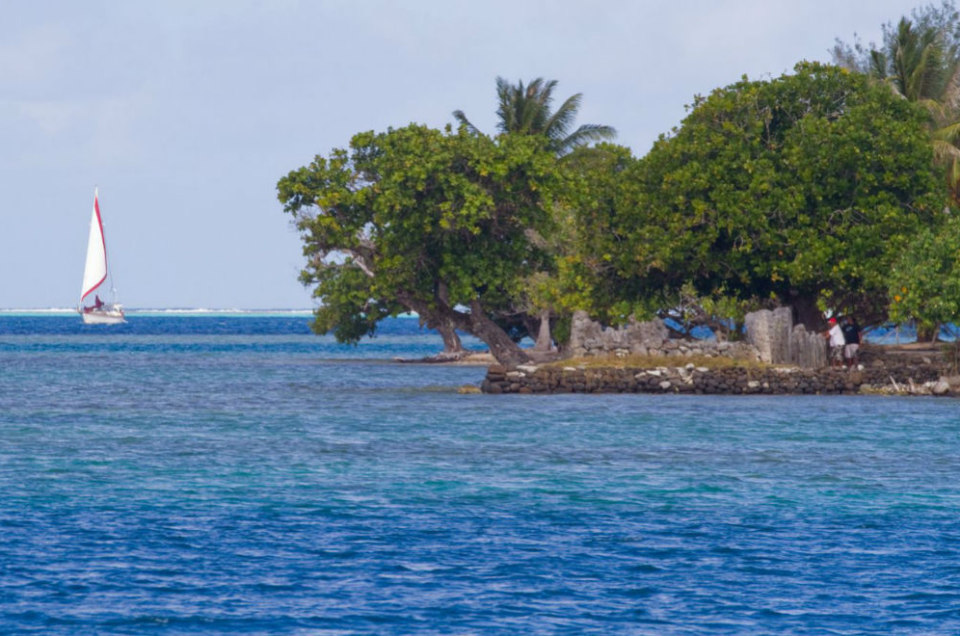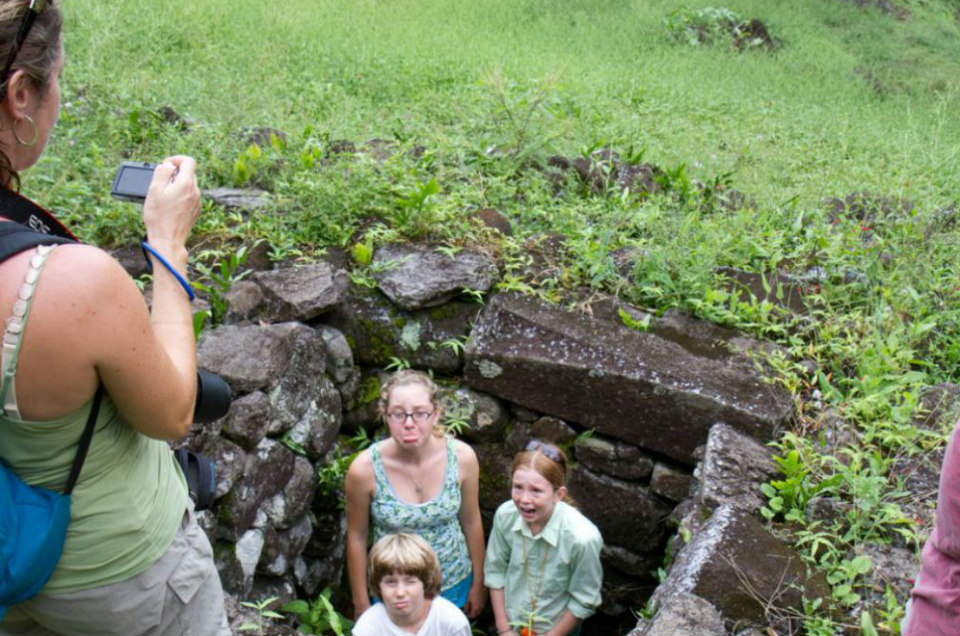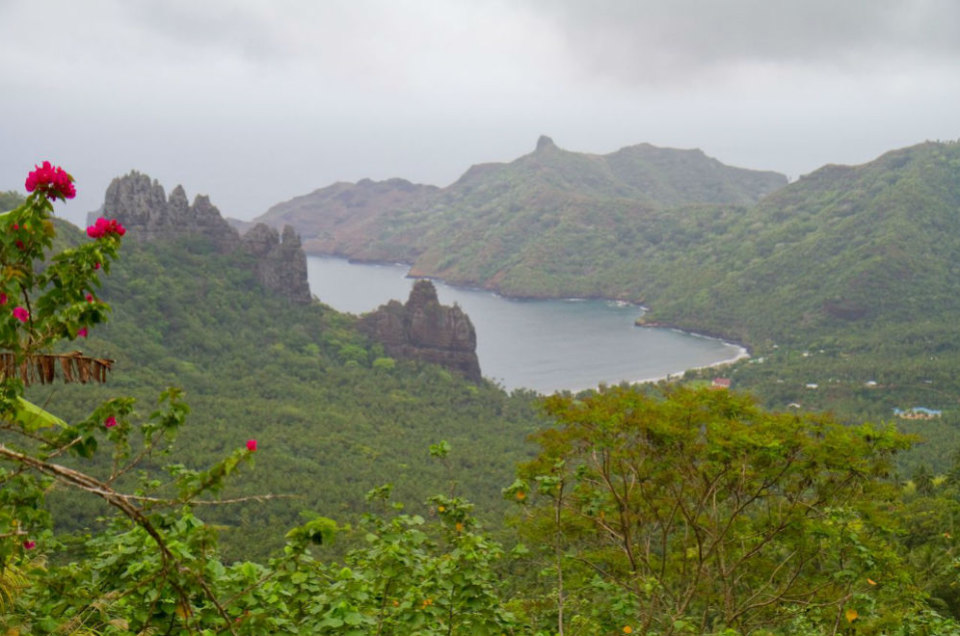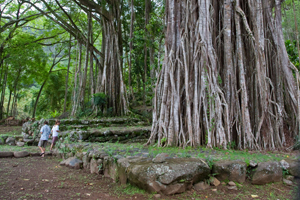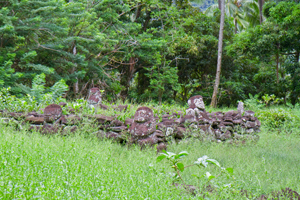A smudge on the horizon.
That’s what land looks like when you first spot it from the sea. And over the course of an hour I kept my eye on one particular smudge–watching its shape take form and hold–ruling out cloud, rainstorm and squall. When I was sure of what I was seeing I called my nine-year-old daughter Maia and husband Evan out on deck. I pointed to the patch of dark grey outlined against a background of medium grey and held Maia’s finger as I traced the shape. “The Marquesas!?” she whispered excitedly.
Then she let loose a, “Land Ho!!” When she looked at her dad, she saw he had tears in his eyes, “But we found it. Why are you crying?”
Early European explorers didn’t have Chart Plotters, Radar and GPS to find the way. And unlike modern sailors who know where they are going (but still feel awe when they actually find land) they tended to stumble across the islands of the South Pacific. Spain’s Alvaro de Mendana accidentally found the Marquesas in 1595 when he set out to colonize the Solomon Islands and his pilot Pedro Fernandez de Quiros missed the island group entirely when he attempted to return in 1606—he ended up in Vanuatu instead.
The Marquesas Islands, with towering fairy-tale cliffs and a rich loamy smell that reaches far out to sea, were first colonized during the Pacific Migration.
It wasn’t until Captain Cook filled in the map during his three expeditions between 1768-1780 that voyagers to the South Pacific began to reliably end up arriving where they intended. And 19 Days, 12 hours after leaving Puerto Vallarta, Mexico when we ghosted into the anchorage at Nuka Hiva, we realized we had Cook to thank for pinpointing the Marquesas.
Estimates vary—but the consensus seems to be the isolated volcanic islands, which are now part of French Polynesia, were settled sometime before 100 AD by voyagers who travelled from Tonga or Samoa. The settlers developed one of the more unique cultures in Polynesia; with a complex social system and a wide range of artistic traditions. They also built huge stone villages with tikis (sacred statues), wide tohuas (stone terraces), pae pae (house foundations) and creepy sacrificial pits.
When Cook arrived in the Marquesas he found that the heavily tattooed locals seemed friendly enough and immediately began trading with them for food. But because the steep mountain sides hemmed everyone in along the shore, Cook ordered that no one should climb the heights where he could make out what he thought were, “Strong holds.”
The strongholds though were sacred marae (religious sites) and not long after we landed in Nuku Hiva we decided to go where Cook dared not venture and headed up to a site that is found in the hills behind the main village of Taiohae. “Kouvea was a communal gathering place that once belonged to the great war chief, Pakoko”, we read in a guidebook as we meandered out of town. Along the way we were distracted by different things: trees heavy with mangoes and breadfruit, luscious flowers, fat roadside pigs and friendly children. Eventually we found ourselves at a lovely viewpoint high above the anchorage, but without a tiki in sight.
So we back-tracked and searched some more but still found ourselves tiki-less. Technically a family that got themselves across an ocean should be able to find an archaeological site they have directions for. But it wasn’t until a local horseman called Roo Touhine took pity on us and led us up a steep track through the jungle that we found our way.
The ancient marae sites were separate from the village sites and were often tapu (taboo) for women, children and lower class types to visit. And as Maia and I pushed through brambles and swatted mosquitoes we decided this made those ancient women and kids sort of lucky, because unless they were being sacrificed they had had no call to hike up a mountain in the heat. Eventually though we arrived at a long stone wall and Roo pointed our way in.
I’m a sucker for ruins and can spend hours exploring the rubble of forgotten civilizations. What I love most is to wander slowly and silently, taking in different vantages. Sometimes I swear I feel the echoes of the long ago people. And as I wandered and explored Kouvea and the other ruins of Nuku Hiva I tried to imagine the nearly forgotten culture that once inhabited these peaceful spaces. With soaring Banyon trees, stone platforms, wide lawns and stern looking tikis these marae have a mystical feel.
After bonding with the tikis (while doing our best not to touch them because doing so can release their bad spirits…) and dropping Maia and her friends in one of the sacrifice pits (archaeologists found sculls and other signs of cannibalism at nearby sites) I closed my eyes and tried to sense the past—what I wanted most was to feel the excitement that must have swept through the villages when the first ships arrived.
“Why did the people stop coming here?” Maia asked me as we sat in the shade of a banyan tree that five men with arms outstretched couldn’t encircle. I pondered how to tell her about what happened after those first ships came. How excitement must have turned to sorrow, as disease and colonization struck and the Marquesan culture was left in ruins. Instead I told her the story of how modern Marquesans have been rebuilding their lost traditions—rediscovering their art and music and taking new pride in their language. I explained that in many places churches had been built on top of the sacred marae sites—and the people often worshiped there now instead.
At anchor that night we listened to drums reverberating through the jungle. Then we pulled out the charts and planned our route through the rest of French Polynesia. We’d visit the Tuamotus, a chain of 78 coral reef atolls that were dubbed “the Dangerous Archipelago” by French explorer Lois-Antoine de Bougainville. And then we’d head on to Tahiti where we’d anchor where both Cook and Bligh had—and from there we’d visit more of the forgotten cities of ancient Polynesia.
The Archaeological Wonders of French Polynesia:
For those who love historic ruins, French Polynesia is a fantastical open-air museum which is scattered with so many archaeological sites that only a fraction have been located and excavated.
The huge jungle sites located throughout the Marquesas are matched by equally impressive sites on Tahiti, Moorea, Huahine, Raiatea and Tahaa.
Getting Around
Private yacht is one option for seeing French Polynesia with kids (though it might not be the most practical) a better bet would be to book a cruise on the Aranui 3 a mixed passenger/cargo vessel that operates between Tahiti and the Marquesas or make the three hour flight from Tahiti.
